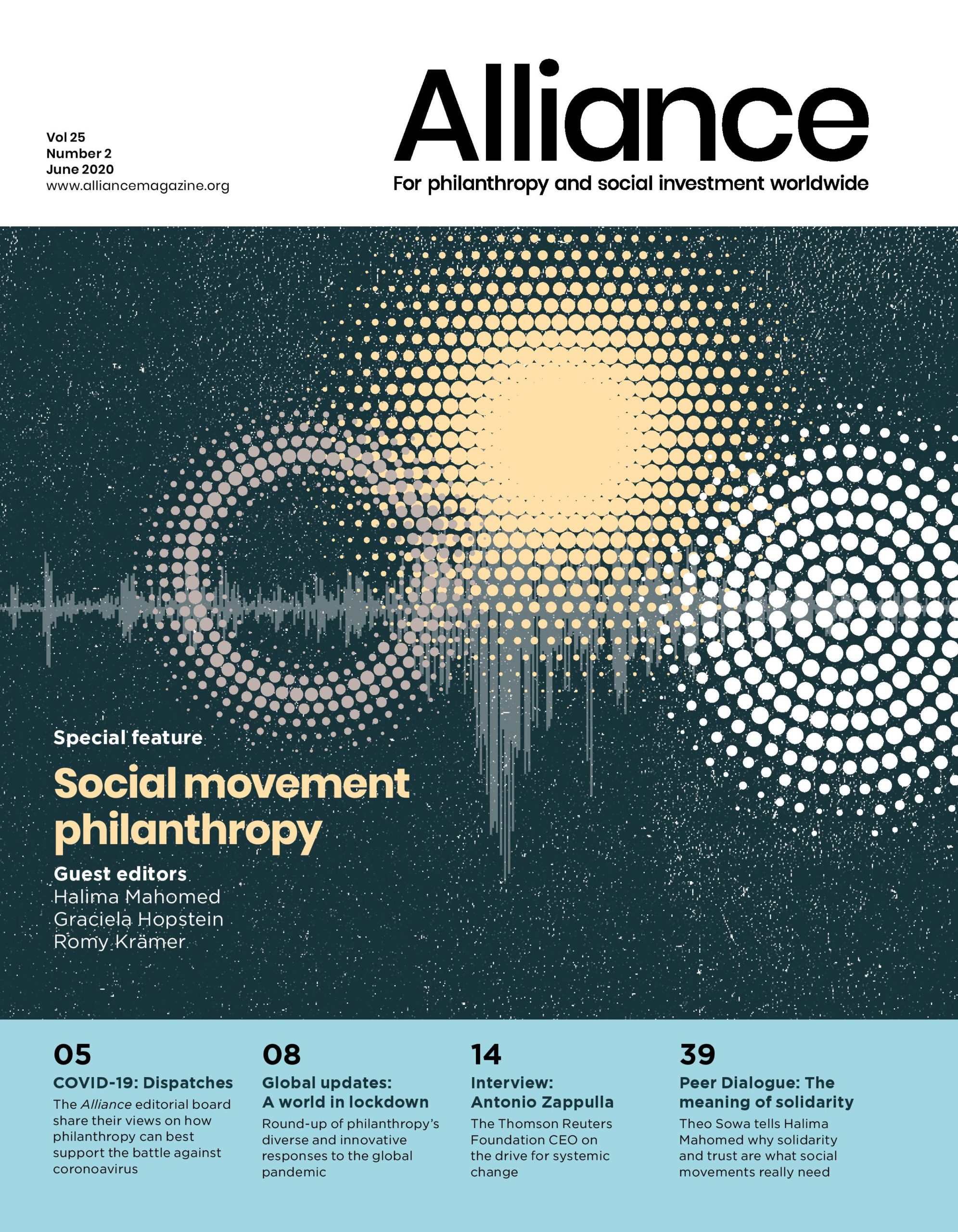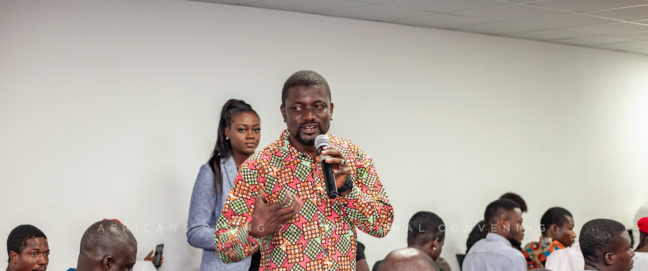Philanthropy is falling short when it comes to supporting the climate justice movement that is rapidly growing across the globe
Despite what he terms ‘amnesia and individualism’, Nathan Thanki of Global Campaign to Demand Climate Justice sees a growing awareness of a self-conscious climate movement in Europe: ‘Although still frequently thinking and acting in a silo, systems-thinking is increasing. Although it still tends towards euro-centrism and tokenism it at least exhibits a desire to act in solidarity with southern movements.’
In Brazil, the climate justice movement is in its infancy, says Alice Amorim of Instituto Clima e Sociedade. For one thing, it has been assumed up to now that the role of the climate movement was to be a sort of informal repository of knowledge for a state working towards the same end. This has changed with the Bolsonaro regime. Second, high levels of poverty in Brazil meant that many assumed ‘that social and economic justice would have precedence over climate justice’. Finally, no-one is sure how current legislation can be used to pursue climate justice. Amorim notes a change, however, with the increasing recognition of inequality and the realisation that climate injustice contributes to it. She sees the movement ‘being led by young organisations, mostly under the leadership of women, with a strong social connection and desire to combat the status quo in which climate change is an important but not the only issue to be addressed’.
Kevin Buckland of Artivist Network also notes that the climate justice movement in Spain is just getting going. While he thinks it is ‘a decade behind other parts of the [climate] movement’ that brings at least one advantage: learning from their mistakes. ‘We’ve been able to skip the individualist-recycling phase and jump straight into structural critique… and to build decolonial and anti-racist organising practices into our work from the very beginning,’ he says.
The major challenges
Among the biggest challenges, Amorim cites capacity building and – predictably – funding.
There will be more to say about funding later, but in terms of capacity building, the most important thing is training in how to use the existing legal machinery to get at the levers of power, because, she believes, ‘campaigns and public mobilisations… are not changing substantially the reality in the country’. Moreover, approaching the issue through lawsuits means engaging in a long protracted process and ‘a timeframe for planning that almost no organisation in Brazil operates with’.
The climate justice movement needs more money and less interference… [it] must build people power and the process for doing this is not one that lines up with funding cycles, processes, and requirements.’
The urgency of the situation, says Buckland, ‘means an escalation of tactics, and many new activists are required to jump straight into non-violent direct action’. However, there is ‘the huge lack of funding for climate activists’, with a corresponding ‘organising gap… in the important work of coordination between local groups and actors, with very few people financially compensated for this work’. He adds: ‘The size of the climate movement is no longer the problem – the missing piece is regional and national capacity for coordination to allow for aligned strategies.’

Each year a lack of resources leaves leading climate activists having to meet in the margins of UN climate summits.
Tatiana Garavito of Wretched of the Earth agrees that size is not what matters. For her, a key problem is the understanding of power by the mainstream environmental movement. ‘Big NGOs and well-funded groups behind the movement appear to be interested in power that is displayed as big protests,’ whereas the kind of power needed should be ‘rooted in deep growth as opposed to growth in numbers, action or a mere change of narrative’. And what’s deep growth? ‘Nurturing relationships with each other and everything around us, creating systems of care, support and accountability, repairing marginalised communities both in the Global South and in the West, and a radical commitment to solidarity.’
Climate, justice and climate justice
Power is the real question for Thanki, too: ‘The principal challenge is that we do not have enough power and are prevented from building it within the movement by actors that have a vested interest in preserving existing power relations… many environment and development NGOs active within the mainstream climate movement are actually not interested in the radical kind of structural changes that the climate justice movement proposes.’
This brings up another point. The climate justice movement is often not clearly distinguished from the climate movement, even in the minds of those involved. Moreover, this confusion is sometimes deliberately fostered by the mainstream movement whose component organisations, Thanki feels, are often ‘very interested in the appearance of being relevant and radical and therefore in the label climate justice’. Garavito also notices that, ‘some organisations in the mainstream environmental movement adopt (or rather co-opt) the language of climate justice movements without living up to what it means – without a real transformation in how they work and without a deeper analysis of what is required from us/them.’
One of the biggest problems in this regard, she feels, is ‘understanding what climate justice movements mean by justice, this requires them [the mainstream movement] to explore how they themselves continue to benefit from the root causes of climate change: colonialism, racism, sexism, classism and how that continues to be represented in their work.’ She adds that, ‘unless they are prepared to deeply change their internal practices as to what it means to work for climate justice, they will continue to advocate for “solutions” that perpetuate the injustices that led to where we are.’
Funders and relations with funders
All are agreed on the need for more funding. ‘To put it bluntly,’ says Thanki, ‘the climate justice movement is funded by collecting crumbs (re-grants) from the table of the mainstream climate movement, which itself is funded by foundations, developed country governments, and crowdfunding. Funding for the Spanish climate action network, says Buckland, has come ‘from the Guerrilla Foundation and Patagonia,1 small grants which allow it ‘to carry out major training projects and hold basic coordination meetings’, but ‘insufficient for us to financially liberate anyone to shoulder the “reproductive” work of movement coordination’.
There needs to be a major push for the ‘baby boomers’ to liquidate their savings to fight this urgent crisis. Any action now is exponentially more useful than any action later.
However, the restrictions funders impose can be as problematic as the absence of money. Buckland voices a complaint that movements of all kinds will probably recognise: ‘Often large institutional funders have so much bureaucracy that small groups simply cannot handle it, or the specification of the projects must be so precisely defined that it does not leave space for the movement to react.’ Funders, he believes, are ‘frequently unresponsive to movement people. Securing funding depends so much on personal relationships and brand recognition.’
Thanki puts it more bluntly: ‘The climate justice movement needs more money and less interference… [it] must build people power and the process for doing this is not one that lines up with funding cycles, processes, and requirements.’ And as usual, implicit in this is the question of power. The movement, believes Garavito, needs ‘ongoing and long-term support’, and ‘small, unfunded groups need funders to understand their own privilege and the power that comes with it. Movements need organisations and foundations that can live up to the values they say they hold.’
What support is needed?
There is a further corollary to the question of power. Garavito observes that one of the most important calls of climate justice movements is the call for reparations, so ‘climate justice movements need everyone, including funders to have that as a demand and to lead by example. This means redistributing power and money to the communities where resources and knowledge have been extracted from, so they can adapt and justly transition.’
Amorim would like the ability to ‘dialogue about failure and success of climate justice projects’. Here, ‘litigation is key to separate what is a win or success legally and in terms of awareness raising or precedent building. This common understanding needs to be built from the beginning of the relationship between organisation and funder and needs to be more tailor-made than other types of projects.’
While locally, the climate movement is ‘well networked,’ believes Buckland, ‘on a global scale, there is no real support for networked coordination of active movements.’ He objects to what he calls the need for the global climate justice movement to ‘piggybacking on the COPs just to be able to meet and strategise, instead of there being resources for the world’s leading climate movements to come together – on our own terms – and build common strategy.’
In a brutal summing-up, he adds: ‘In 15 years of climate activism I have not seen a good model of support for climate activism that is on scale with the crisis.’
The Bezos contribution
Opinions were divided sharply on the question of the Bezos Earth Fund.2 ‘It is an excellent move and should be followed by other millionaires, especially from the Global South,’ says Amorim. ‘Giving donations to the Amazon Region, where climate injustice is so present would be an excellent contribution to this field.’ Buckland is also willing to applaud, but thinks others should follow Bezos’ example. ‘There needs to be a major push for the “baby boomers” – the generation that has seen atmospheric CO2 grow by a quarter – to liquidate their savings to fight this urgent crisis. Any action now is exponentially more useful than any action later.’
Thanki is less laudatory. While he feels that Bezos shouldn’t be discouraged from his contribution towards the solution of the crisis, he should be prevented from doing so ‘in such a way as to benefit his business interests. I realise for people working in the world of philanthropy this will sound like polemic and certainly there is more complexity to this than my answer suggests but it’s hard not to be cynical about the intentions of the top when you’re at the bottom.’
Grounds for hope
Where are the grounds for optimism in all this? Amorim sees hope in the capacity and willingness to innovate: ‘Despite all these difficulties, I see the movement intrigued by the theoretical and practical challenges that advancing action based on climate justice concepts and narratives impose.’
Garavito finds hope in groups that are trying to understand ‘how oppression shows up in their work, reframing joy and pleasure and in doing so creating the new worlds we need. I also find hope in groups that are actively finding ways to collaborate, to work on building community, the ones that are reaching out to those who have been alienated by our work, the ones that are interested in speaking with people outside our bubbles to build new ways of relating.’ These groups ‘don’t talk the loudest but they do the transformational work that is required to build new alliances and collaborations. I also find hope in climate justice movements – especially from the Global South – that continue to organise and resist despite deadly state violence, even while they lack access to the resources and platforms available to the “mainstream” environmental movement resources and platforms to speak up.’
The climate crisis is… ‘not a technical or technological matter but rather a matter of transforming the systems that underpin every aspect of our civilisation.’
Meanwhile, there are some successes to celebrate. Amorim believes that the recent ruling in the Urgenda Case3 in the Netherlands ‘changed the history of the climate justice movement. A new wave of climate justice narratives, approaches and ideas have been flourishing since then and as a result of this well conceived legal case.’
A success for Buckland is that ‘Indigenous groups, networks from the Global South, and racial justice climate organisers have succeeded in pulling climate out of the “environment” and grounded it in the complex power structures that co-inhabit the world today,’ so that the movement is no longer simply attacking ‘the symptom of structural oppressions’.
It has compelled the mainstream climate movement ‘to acknowledge three things (to varying degrees)’, says Thanki. One is the scale of the challenge. ‘Now many are talking about an emergency whereas climate justice movements were describing the situation in these terms at least a decade ago.’ The second is that the climate crisis is ‘not as simple as emissions reductions – it is not a technical or technological matter but rather a matter of transforming the systems that underpin every aspect of our civilisation.’ Third is that the solution depends on ‘people power’, though this poses a further challenge, since he believes that ‘mainstream actors have no idea how to do this’ and are ‘rooted in their belief of elite strategies of advocacy’.
Garavito says something similar: ‘The climate justice movement has managed to make the wider, mostly apolitical environmental movement explore the importance of justice in their approach, and to look at the root causes of injustice. So in a way they have politicised a movement that had mainly been interested in individual approaches to climate change or action merely around reducing emissions in the Global North.’
With a few exceptions, then, funders have been slow to get behind the climate justice movement. In part, this seems to be because of the customary funder preference for dealing with an organisation that looks superficially at least like its own – a staff, a board and an office – but it is also because of its failure or refusal to recognise that the climate justice movement has its own distinctive set of needs and demands.
Pullquote to read: There needs to be a major push for the ‘baby boomers’ to liquidate their savings to fight this urgent crisis. Any action now is exponentially more useful than any action later.
Alliance would like to thank the following for contributing to this article:
Alice Amorim, coordinator, Climate Policy and Outreach Portfolio, Instituto Clima e Sociedade.
Kevin Buckland, director, Artivist Network.
Tatiana Garavito, organiser and facilitator, Wretched of the Earth.
Nathan Thanki, co-coordinator, Global Campaign to Demand Climate Justice.






Comments (0)